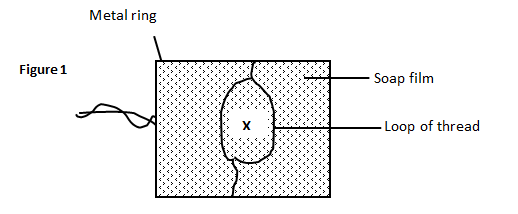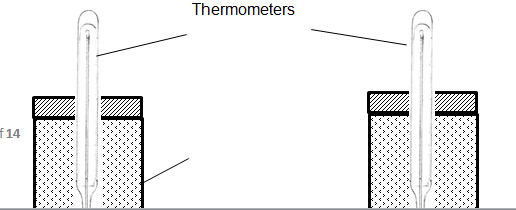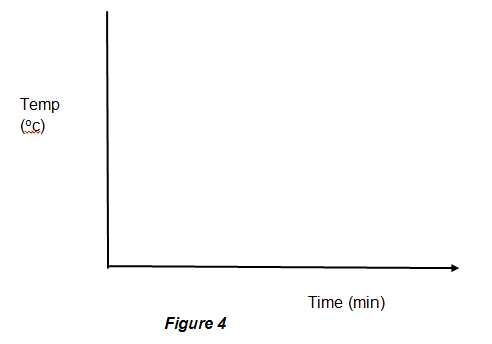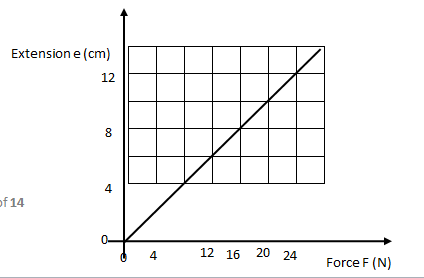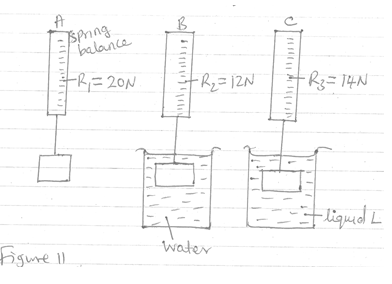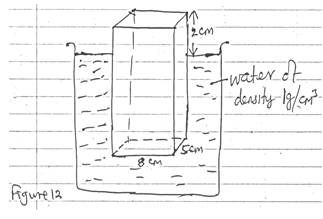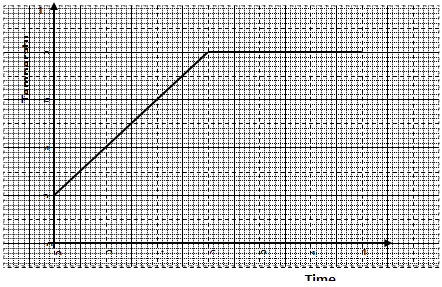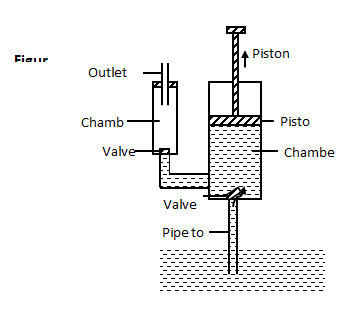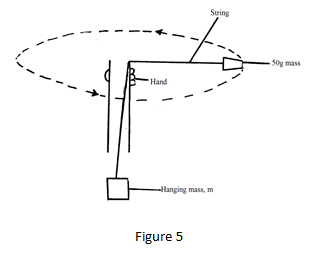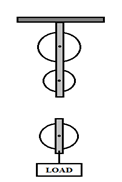Section A (25 marks)
Answer ALL the questions in the spaces provided
- Mechanics is one of the branches of physics. State what it deals with. (1mark)
- In an experiment to determine the relative density of a substance using a density bottle the following measurements were taken.
- Mass of empty density bottle = 43.2 g
- Mass of bottle full of water = 66.4 g
- Mass of bottle filled with liquid X = 68.2g
Use the data to determine the density of the liquids. (3marks - Figure 1 below shows a soap film formed on a metal ring and a loop of thread inside it.
- Explain what will happen when the film is punctured by a needle at X. (2marks)
- What is the name given to the force acting on the thread? (1mark)
- Why are gases more compressible while liquids and solids are almost incompressible? (1mark)
- Explain why when graduating the upper fixed point of a thermometer; the bulb is put in steam above boiling water and not boiling water. (1marks)
- While heating water in a beaker, wire gauze is place below the beaker. Explain. (2marks)
- A ball bearing of mass 1.5 x 10- 4 kg is held between the anvil and spindle of a micrometer screw gauge as shown in the Figure 2 below.
Before the instrument was the zero error was found to be 0.03 mm.- What is the diameter of the ball bearing? (2mark)
- Find the density of the ball bearing correct to 3 significant figures and in SI units. (2marks)
- Explain why a Matatu is more likely to topple over when the roof rack is heavily loaded than when the roof rack is empty. (2marks)
- .Figure 3 shows two identical metallic cans A and B, filled with water at room temperature. An electric heater is placed at equal distances from A and B.
In figure 4 sketch a graph to show the variation of temperature with time for the two surfaces. (2 marks
- The graph shows variation of extension and stretching force F for a spring which obeys Hooke’s law.
- Determine the spring constant in SI units. (1mark)
- The energy stored when the extension is 20cm. (2marks)
-
- An aero plane is moving horizontally through still air at a uniform speed. It is observed that when the speed of the plane is increased, its height above the ground increases. State the reason for this observation. (1mark)
- Figure 5 shows parts A, B and C of a glass tube. State with a reason the part of the tube in which the pressure will be lowest when air is blown through the tube from A towards C. (2marks)
Section B (55 marks)
Answer ALL the questions in the spaces provided
-
- State Archimedes’ principle (1 mark)
- Figure 10 below shows an hydrometer
- What is the purpose of this instrument (1 mark)
- What is the use of the lead shots at the base of the instrument ( 1 mark)
- Why would the bulb have a large volume? (1 mark)
- The set up shown below was used by a student to determine the density of a liquid.
Use the information from the set up above to calculate.- The density of the solid ( 3marks)
- The density of liquid L (3 marks)
- Figure 12 below shows a solid measuring 8cm by 5cm and of light 10cm
Calculate the force that should be applied to the block so as to get completely submerged. (4 marks)
-
- State two differences between boiling and evaporation. (2marks)
- 1200 g of a liquid at 200 C is poured into a well-lagged calorimeter. An electric heater rated 1 KW is used to heat the liquid. The graph below shows the variation of temperature of the liquid with time.
Use the graph below to answer the following questions:- What is the boiling point of the liquid? (1mark)
- How much heat is given out by the heater to take the liquid to the boiling point (2marks)
- Determine the specific heat capacity of the liquid stating any assumptions made. (3marks)
- If 50 g of the liquid vapour was collected by the end of the 10th minute, determine the specific latent heat of vaporization of the liquid. (3marks)
-
- State Boyle’s law. (1mark)
- A bicycle pump, with its exit hole closed 80 cm3 of air at 760 mmHg pressures and a temperature of 70 C. When the air has been compressed to 38 cm3 under 1720 mmHg pressure, its temperature rises.
- Calculate the rise in temperature. (3marks)
- Explain why the temperature rises. (1mark)
- Figure 5 below shows a force pump
- Explain why when the piston is pulled upwards valve 1 opens and valve 2 closes. (2marks)
- Explain how continuous flow of water is maintained in the pump. (1mark)
- State one advantage of force pump over lift pump. (1mark)
-
- State two factors affecting centripetal force. (2mks)
- The setup in figure 5 below shows a 50g mass being whirled on a horizontal circular path and balanced by hanging mass M.
Rotich used the above setup to investigate the variation of periodic time, T and the radius, r of the path of the 50g mass and obtained the result shown in the table 1.
Radius, r (m)
0.50
0.41
0.33
0.24
0.16
Periodic time, T (s)
0.99
0.90
0.81
0.69
0.56
T2 (s2)
- Complete the table (1mk)
- Use table 1 above to draw the graph of T2 against r on the grid provided (5mks)
- From the equation , determine from the graph the value of the force, F that keeps the 50g mass in the horizontal circular path (i.e m = 50g) (4mks)
-
- Name a device used to convert light energy directly into electrical energy. (1 mark)
- A girl whose mass is 60 kg runs up a flight of 20 steps each 15 cm in 40 seconds. Calculate the power developed by the girl. (2 marks)
-
- The figure below shows an incomplete arrangement of the pulley. Draw on the diagram the string arrangement that would give a velocity ratio of 3. (1 mark)
- The pulley system is used to raise a load of 160 N through a distance of 40m. If the effort applied is 80N, determine
- Mechanical advantage (2 marks
- Efficiency of the pulley system (3 mark)
- The figure below shows an incomplete arrangement of the pulley. Draw on the diagram the string arrangement that would give a velocity ratio of 3. (1 mark)

MARKING SCHEME
- Mechanics is one of the branches of physics. State what it deals with. (1 mark)
Study of motion of bodies under the influence of forces.;
- In an experiment to determine the relative density of a substance using a density bottle the following measurements were taken.
- Mass of empty density bottle = 43.2 g
- Mass of bottle full of water = 66.4 g
- Mass of bottle filled with liquid X = 68.2g
Use the data to determine the density of the liquids. (3marks)
Density = mass of substance/volume of equal volume of water = ; ; = = 1.078g/cm;;
- The figure below shows a soap film formed on a metal ring and a loop of thread inside it.
- Explain what will happen when the film is punctured/pierced by a needle at X. (2marks)
The loop of thread stretch to form a perfect circular loop.; Surface tension pulls the thread along the length of the thread making the loop.; - What is the name given to the force acting on the thread? (1mark)
Surface tension;
- Explain what will happen when the film is punctured/pierced by a needle at X. (2marks)
- Why are gases more compressible while liquids and solids are almost incompressible? (1mark)
There exists large intermolecular distance between the molecules;
- Explain why when graduating the upper fixed point of a thermometer; the bulb is put in steam and not boiling water. (1marks)
Impurities in water raise the boiling point of water. - While heating water in a beaker, wire gauze is place below the beaker. Explain.(2marks)
The gauze being a good conductor ;spreads heat to the whole of the bottom of the beaker. ;Direct heating might cause the beaker to break due to expansion in a small area
- A ball bearing of mass 1.5 x 10-4 kg is held between the anvil and spindle of a micrometer screw gauge as shown in the figure below.
The reading between completely closed jaws without any object between them is 0.03 mm.- What is the diameter of the ball bearing? (2mark);
2.83 -0.03 = 2.80 mm, - Find the density of the ball bearing correct to 3 significant figures and in SI units. V = x x 0.143 = 0.01149866 cm3
Density = ; = 13.04499 g/cm3 ;(2marks)
- What is the diameter of the ball bearing? (2mark);
- Explain why a Matatu is more likely to topple over when the roof rack is heavily loaded than when the roof rack is empty. (2marks)
The cog is raised; so that when negotiating a corner the line through the cog may fall outside the base. ;
- The graph shows variation of extension and stretching force F for a spring which obeys Hooke’s law.
- Determine the spring constant in SI units .(2marks)
K = = ; = 200N/m; - The energy stored when the extension is 20cm. (2marks)
E = ½ Ke2 = ½ x 200 x 0.22 ;= 4J;
- Determine the spring constant in SI units .(2marks)
-
- An aero plane is moving horizontally through still air at a uniform speed. It is observed that when the speed of the plane is increased, its height above the ground increases. State the reason for this observation. (1mark)
Air above the plane moves faster than below(because of its shape) creating a region of low pressure above the plane hence experience a lift due to pressure difference.;(b) Figure 5 shows parts A, B and C of a glass tube. - State with a reason the part of the tube in which the pressure will be lowest when air is blown through the tube from A towards C. (2marks)
B; because the cross-sectional area is smaller hence the air moves faster;
- An aero plane is moving horizontally through still air at a uniform speed. It is observed that when the speed of the plane is increased, its height above the ground increases. State the reason for this observation. (1mark)
Section B (55 marks)
-
- When a body is partially or totally immersed in a fluid, it experiences an uptrust equal to the weight of the fluid displaced.
-
- Measure density or relative density of liquids.
- To make it float upright.
- To displace large amount of liquid.
-
- ww = 20 – 12 = 8N
R.d(s) = 20N = 2.5
8N
Ls = 2.5 x 1g/cm3 = 2.5g/cm3 - R.d(l) = 6N = 0.75
8N
Ll = 0.75 x 1g/cm3
= 0.75 g/cm3
- ww = 20 – 12 = 8N
- Volume of water to displace
8 x 5 x 2 = 80cm3
mw = 80 x 1g/cm3
= 80g
ww = 0.08kg x 10
= 0.8N
-
- State two differences between boiling and evaporation. (2mks)
- Boiling is the change of state form liquid to vapor at constant temperature while evaporation takes place at any temperature.;
- Boiling takes place throughout the liquid while evaporation takes place on the surface of the liquid.; - 1200 g of a liquid at 200 C is poured into a well -lagged calorimeter. An electric heater rated 1 KW is used to heat the liquid. The graph below shows the variation of temperature of the liquid with time.
Use the graph below to answer the following questions:- What is the boiling point of the liquid? (1mark)
800C; - How much heat is given out by the heater to take the liquid to the boiling point? (2marks)
E = Pt = 1000 x 6 x 60 ;= 360000J; - Determine the specific heat capacity of the liquid stating any assumptions made. (3marks)
Pt = mc Δθ; c = ; = 5000J/kgK;
Mlv=pt v =1000x4x60=50/1000xlv v
240000=0.5lv
=4800000j/kg/k
- What is the boiling point of the liquid? (1mark)
- State two differences between boiling and evaporation. (2mks)
-
- State Boyle’s law. (1mark)
It states that the pressure of a fixed mass of a gas is inversely proportional to its volume provided temperature is kept constant. - A bicycle pump, with its exit hole closed 80 cm3 of air at 760 mmHg pressures and a temperature of 70 C. When the air has been compressed to 38 cm3 under 1720 mmHg pressure, its temperature rises.
- Calculate the rise in temperature. (3marks)
Use equation =k, P1= 760mmHg, P2=1720mmHg, V1=80cm3, V2=38cm3,
T1= 280K, T2=?
T2 = ; = 301K;
Temperature rise = 301 – 280 = 210C; - Explain why the temperature rises. (1mark)
The increase in temperature increases the rate at which the molecules bombard the walls of the container therefore their kinetic energy is converted into heat energy hence rise in temperature. This is the work done is compressing the gas converted to heat energy.
- Calculate the rise in temperature. (3marks)
- State one advantage of force pump over lift pump. (1mark)
Does not depend on atmospheric pressure;
Produces continuous flow of water - The figure below shows a force pump
- Explain why when the piston is pulled upwards valve 1 opens and valve 2 closes. (2marks)
Pressure in Y is less than atmospheric pressure.; Water is pushed into Y opening valve 1. Valve 2 closed chamber X is at atmospheric pressure; - Explain how continuous flow of water is maintained in the pump. (1mark)
Maintained by the compressed air in chamber X which expands. - State two factors affecting centripetal force.
Velocity of the body,Mass and Radius of the circle.
- Explain why when the piston is pulled upwards valve 1 opens and valve 2 closes. (2marks)
- State Boyle’s law. (1mark)
-
- Name a device used to convert light energy directly into electrical energy. (1 mark)
……photocell…………………………………………………………………………………………… - A girl whose mass is 60 kg runs up a flight of 20 steps each 15 cm in 40 seconds. Calculate the power developed by the girl. (3mk)
……………P=mgh/t
60x10x20x1.5/40
45w -
- The figure below shows an incomplete arrangement of the pulley. Draw on the diagram the string arrangement that would give a velocity ratio of 3 (1 mark)
- The pulley system is used to raise a load of 160 N through a distance of 40m. If the effort applied is 80N, determine
- Name a device used to convert light energy directly into electrical energy. (1 mark)
-
- Mechanical advantage (2 marks)
MA=L/E
160/80
2 - Efficiency of the pulley system (3 marks)
E=MA/E X100 V
2/3 X100 V
66.67% V
- Mechanical advantage (2 marks)
Download PHYSICS PAPER 1 - KCSE 2019 MOCK EXAMINATION - KAKAMEGA.
Tap Here to Download for 50/-
Get on WhatsApp for 50/-
Why download?
- ✔ To read offline at any time.
- ✔ To Print at your convenience
- ✔ Share Easily with Friends / Students

